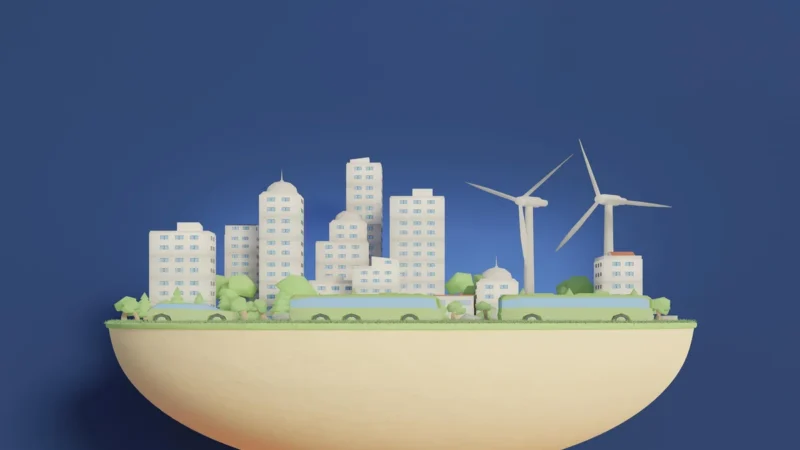Impact of Air Pollution On The Environment: Causes And Solutions For a Greener Future

Air pollution is the presence of harmful substances in the air that can damage the environment and human health. Air pollution is caused by various sources, such as vehicle exhaust, fossil fuel power plants, industrial emissions, construction activities, agricultural activities, and natural phenomena. Air pollution has many negative effects on the environment, such as accelerated global warming, wildlife endangerment, acid rain, ozone depletion, and reduced visibility. Air pollution also poses serious health risks for humans, such as respiratory and cardiovascular diseases, lung cancer, asthma, and allergies. Therefore, it is important to find effective solutions to reduce air pollution and protect the environment and human health.
Causes of Air Pollution
The main causes of air pollution are:
- Vehicle Exhaust: Vehicles emit various pollutants, such as carbon monoxide, nitrogen oxides, hydrocarbons, and particulate matter. These pollutants contribute to the formation of ground-level ozone, smog, and acid rain.
- Fossil Fuel Power Plants: Power plants that burn coal, oil, or natural gas produce large amounts of sulphur dioxide, nitrogen oxides, carbon dioxide, and mercury. These pollutants can cause acid rain, global warming, and toxic contamination.
- Industrial Emissions: Industries such as manufacturing, mining, metal processing, chemical production, and waste disposal release various gases and particles into the air. These include volatile organic compounds, heavy metals, asbestos, dioxins, and radioactive materials. These pollutants can cause cancer, birth defects, neurological disorders, and environmental degradation.
- Construction Activities: Construction activities such as demolition, excavation, drilling, blasting, and road building generate dust and noise that can pollute the air. Dust can reduce visibility and increase respiratory problems. Noise can cause hearing loss and stress.
- Agricultural Activities: Agricultural activities such as crop cultivation, livestock farming, fertilizer use, and pesticide spraying emit ammonia, methane, nitrous oxide, and other chemicals into the air. These pollutants can affect the ozone layer, the greenhouse effect, and human health.
- Natural Phenomena: Natural phenomena such as volcanoes, wildfires, dust storms, and pollen release smoke, ash, dust, and spores into the air. These pollutants can cause respiratory infections, allergies, asthma attacks, and eye irritation.
Effects of Air Pollution
The main effects of air pollution are:
- Accelerated Global Warming: Global warming is the increase in the average temperature of the earth’s surface due to the accumulation of greenhouse gases in the atmosphere. Greenhouse gases such as carbon dioxide, nitrous oxide, methane, and chlorofluorocarbons trap heat from the sun and prevent it from escaping into space. This causes the earth to warm up and disrupts the climate patterns. Global warming can lead to melting ice caps, rising sea levels, extreme weather events, droughts, floods, heat waves, and crop failures.
- Wildlife Endangerment: Air pollution can affect the habitats and food sources of various animals and plants. Air pollution can reduce the availability of water, nutrients, and sunlight for plants. It can also damage the leaves, stems, and roots of plants. This can reduce plant growth, reproduction, and diversity. Air pollution can also affect animals by reducing their food supply, causing respiratory problems, altering their behavior, and increasing their susceptibility to diseases. Air pollution can also cause genetic mutations, birth defects, and reduced fertility in animals.
- Acid Rain: Acid rain is rain that has a lower pH than normal due to the presence of sulphur dioxide and nitrogen oxides in the air. These gases react with water vapor in the atmosphere to form sulphuric acid and nitric acid. Acid rain can damage buildings, monuments, and statues made of limestone or marble. It can also harm forests, lakes, rivers, and soils by leaching nutrients and minerals from them. Acid rain can also affect aquatic life by lowering the pH of water bodies and killing fish and plants.
- Ozone Depletion: Ozone is a layer of gas that surrounds the earth and protects it from harmful ultraviolet rays from the sun. Ozone depletion is the thinning or destruction of this layer due to the release of chlorofluorocarbons (CFCs) and other ozone-depleting substances (ODS) into the air. CFCs and ODS break down ozone molecules in a chemical reaction that is catalyzed by sunlight. Ozone depletion can increase the exposure of living organisms to ultraviolet radiation. This can cause skin cancer, eye cataracts, immune system disorders, and crop damage.
- Reduced Visibility: Reduced visibility is the impairment of vision due to the presence of particles or gases in the air that scatter or absorb light. Reduced visibility can affect transportation, tourism, and outdoor activities. It can also increase the risk of accidents and injuries.
Solutions for a Greener Future
The possible solutions for reducing air pollution and protecting the environment and human health are:
- Using Renewable Energy Sources: Renewable energy sources such as solar, wind, hydro, geothermal, and biomass are clean and sustainable alternatives to fossil fuels. They do not emit greenhouse gases or other pollutants into the air. They also reduce the dependence on imported oil and gas and create jobs and economic opportunities.
- Improving Vehicle Efficiency and Emission Standards: Vehicle efficiency and emission standards are regulations that set the minimum requirements for the fuel economy and pollutant emissions of vehicles. Improving these standards can reduce the amount of fuel consumed and pollutants emitted by vehicles. This can save money, energy, and improve air quality.
- Implementing Industrial Pollution Control Measures: Industrial pollution control measures are technologies or practices that reduce or eliminate the emission of pollutants from industrial processes. These include using filters, scrubbers, catalysts, electrostatic precipitators, and cyclones to capture or destroy pollutants before they enter the air. They also include using cleaner fuels, recycling waste materials, and adopting green manufacturing methods.
- Promoting Green Building Practices: Green building practices are design and construction techniques that minimize the environmental impact of buildings. These include using energy-efficient appliances, lighting, and insulation to reduce energy consumption and greenhouse gas emissions. They also include using renewable materials, water-saving devices, and natural ventilation to reduce resource use and waste generation.
- Encouraging Public Awareness and Participation: Public awareness and participation are essential for reducing air pollution and protecting the environment and human health. Public awareness involves educating people about the causes, effects, and solutions of air pollution. Public participation involves engaging people in taking action to prevent or reduce air pollution. This can include using public transportation, carpooling, biking, or walking instead of driving; planting trees, gardening, or composting to enhance green spaces; and supporting environmental policies, programs, and initiatives that aim to improve air quality.
Video Source:WORLD ECONOMIC FORUM
FAQs
1.What is air pollution?
Air pollution is the presence of harmful substances in the air that can damage the environment and human health.
2.What are the main sources of air pollution?
The main sources of air pollution are vehicle exhaust, fossil fuel power plants, industrial emissions, construction activities, agricultural activities, and natural phenomena.
3.What are the main effects of air pollution?
The main effects of air pollution are accelerated global warming, wildlife endangerment, acid rain, ozone depletion, and reduced visibility. Air pollution also poses serious health risks for humans, such as respiratory and cardiovascular diseases, lung cancer, asthma, and allergies.
4.How can we reduce air pollution?
We can reduce air pollution by using renewable energy sources, improving vehicle efficiency and emission standards, implementing industrial pollution control measures, promoting green building practices, and encouraging public awareness and participation.
5.How can we monitor air quality?
We can monitor air quality by using various instruments and indicators that measure the concentration and composition of pollutants in the air. Some of these instruments and indicators are air quality index (AQI), particulate matter (PM), nitrogen dioxide (NO2), sulphur dioxide (SO2), ozone (O3), carbon monoxide (CO), and volatile organic compounds (VOCs).


